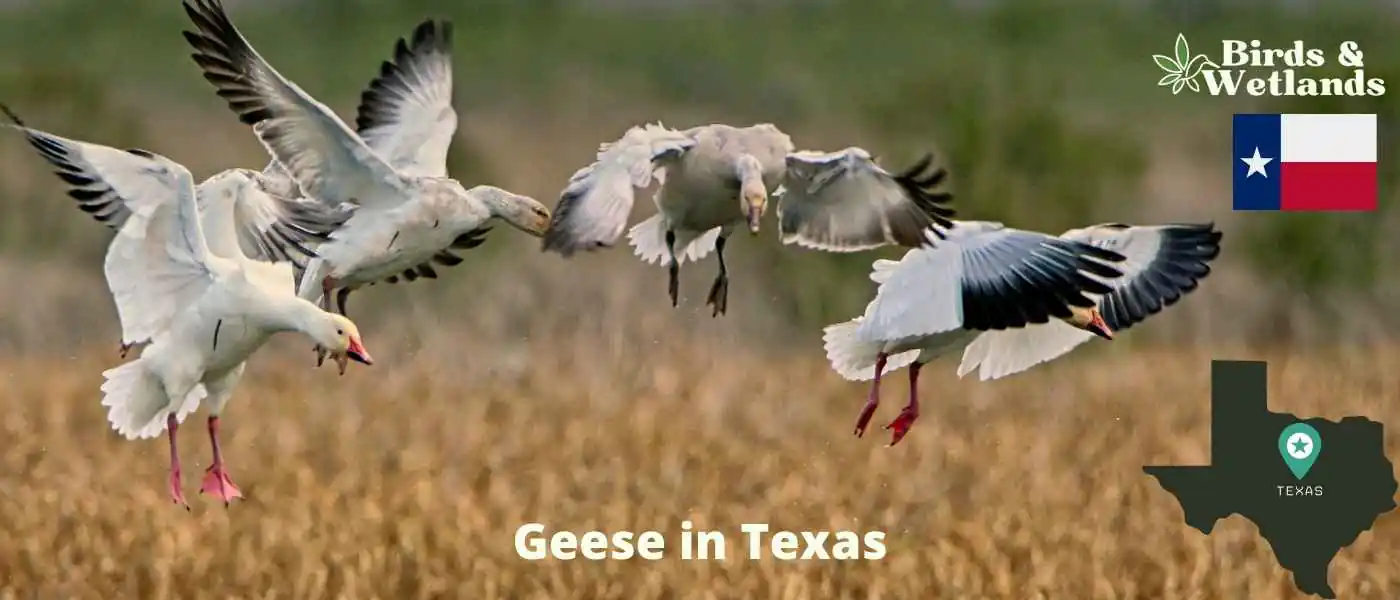There’s something special about the sight of a goose flying overhead. These creatures are found all over the world, and each region has its own unique geese behavior and habits. In this guide, we will take a look at the geese that live in Texas.
What Geese Species are in Texas
There are six geese species found in Texas, with the Egyptian goose being a non-native recent incomer.
- Ross’s Goose
- Cackling Goose
- Greater White-fronted Goose
- Canada Goose
- Snow Goose
- Egyptian Goose
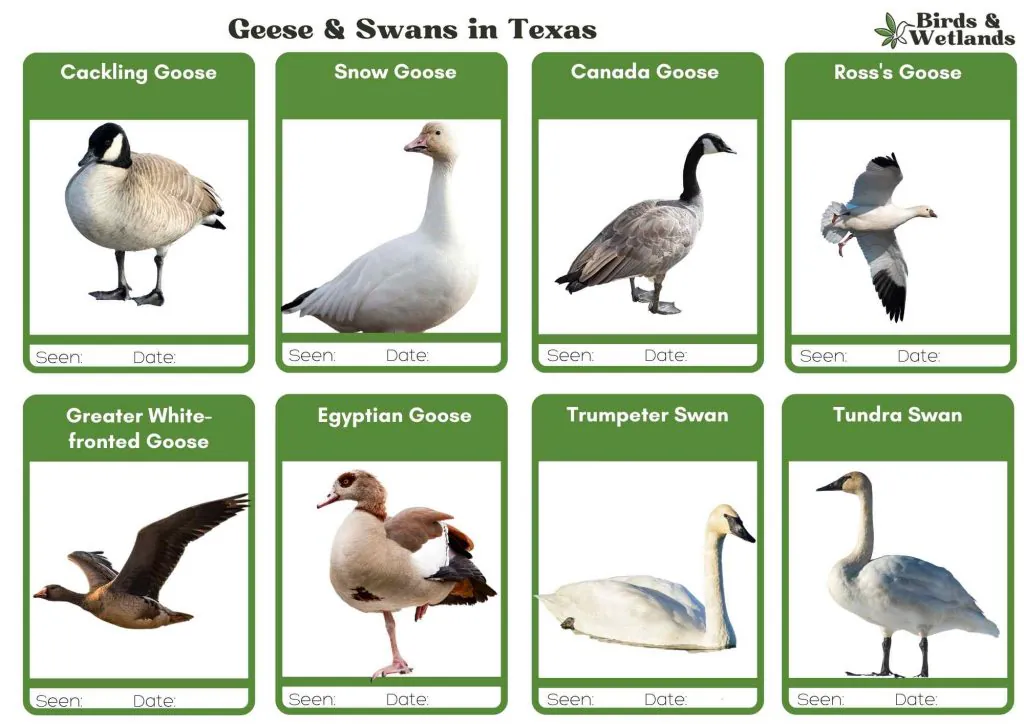
Ross’s Goose
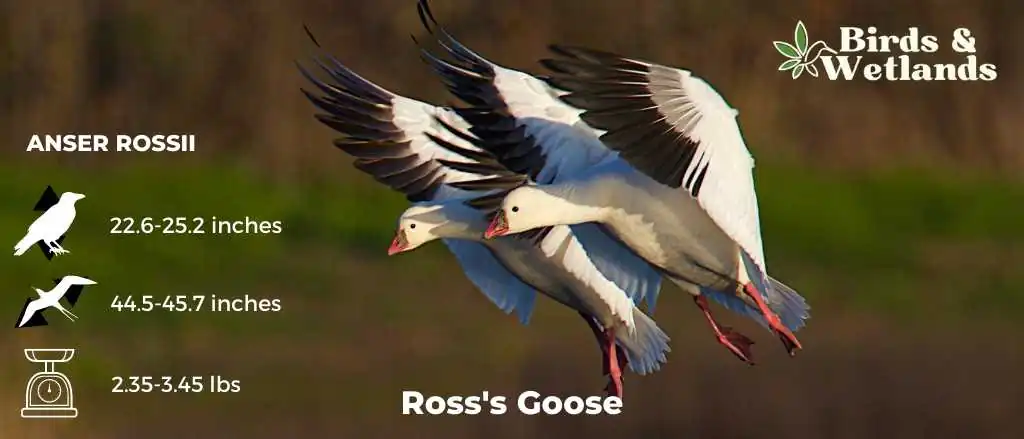
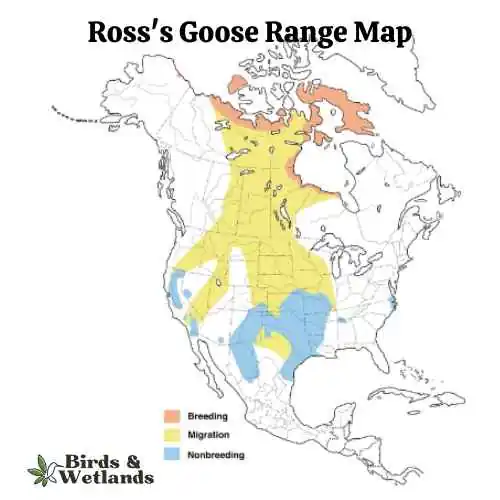
Listen
Scientific Name: Anser rossii
Length: 23.2-25.2
Wingspan: 44.5-45.7 in
Weight:42.3-55.3 oz
The Ross’s Goose is a small species of waterfowl often found in North America’s tundra and wetland habitats.
Appearance: Known for its compact size, the Ross’s Goose is mostly white with black wingtips. It features a short, stubby bill and a rounded head. One key identifying feature is the blueish gray base of its bill, which has a warty structure during the breeding season.
Diet: This goose feeds mainly on vegetation, including seeds, leaves, and roots of grasses and sedges. During winter and migration, they also consume grains and seeds from agricultural fields.
Reproduction: The Ross’s Goose nests on the ground, often in colonies. The female lays a clutch of 2 to 5 eggs which she incubates for around three weeks. The young geese, known as goslings, are precocial – they can walk, swim, and feed themselves shortly after hatching, although they stay with their parents until they learn to fly.
Cackling Goose
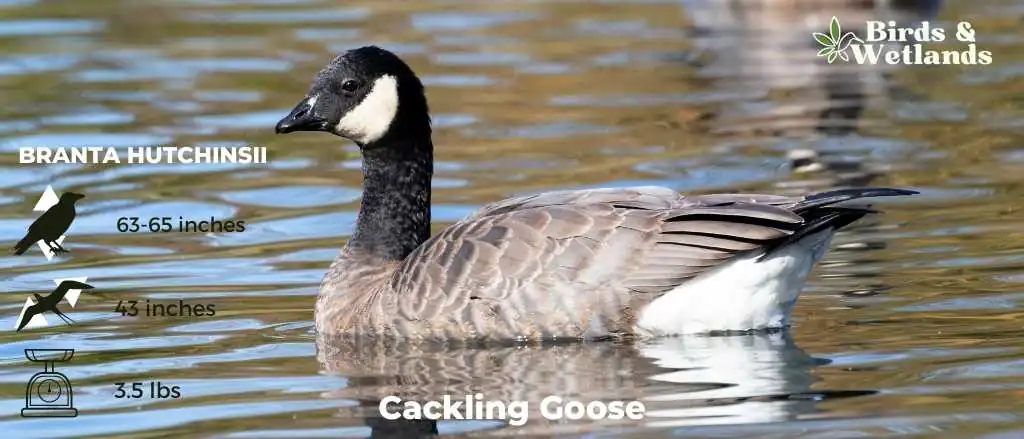
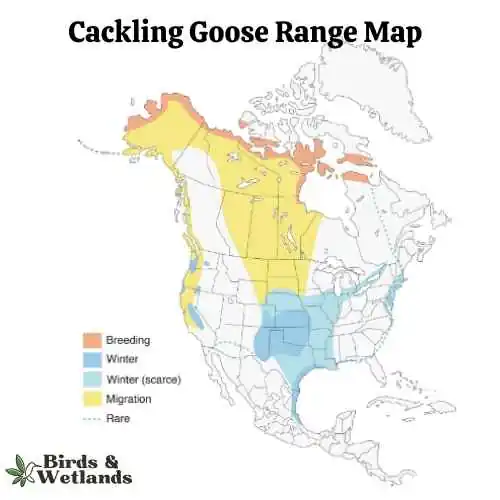
Listen
Scientific Name: Branta hutchinsii
Length: 24.8–25.6 in
Wingspan: 43-45.7 in
Weight:3.5 lbs
Cackling Geese are particularly known for their high-pitched, cackling calls, which is the source of their name. Despite their small size, these geese are renowned long-distance migrants, with some populations traveling thousands of miles between breeding and wintering grounds.
Appearance: With a similar color pattern to the larger Canada Goose, the Cackling Goose features a black head and neck, white chinstrap, light tan to cream chest, and brownish-grey body. One defining characteristic is its noticeably smaller size and stubbier neck compared to its larger counterparts.
Diet: Like many geese, the Cackling Goose’s diet mainly consists of plant matter. This includes grasses, seeds, and aquatic vegetation. They are often seen grazing on land or dabbling in shallow water.
Reproduction: Cackling Geese usually nest on the ground in elevated areas near water bodies, such as riverbanks or lakeshores. The female lays a clutch of 2 to 8 eggs and is responsible for incubation, while the male stands guard nearby. Incubation lasts for about a month.
Greater White-fronted Goose
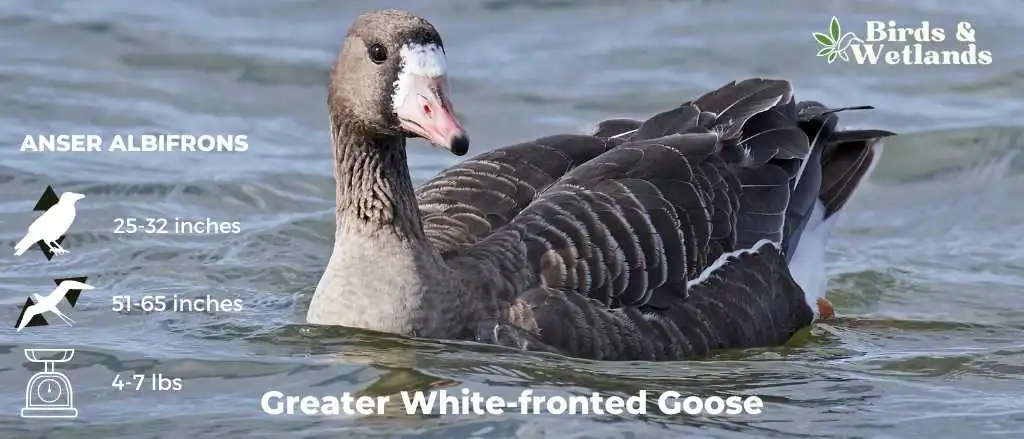

Listen
Scientific Name: Anser albifrons
Length: 25 to 31 in
Wingspan: 53 to 66 in
Weight: 3.3 to 6.6
The Greater White-fronted Goose is a medium to large waterfowl species, widely distributed across the Northern Hemisphere, particularly in North America.
Appearance: As the name suggests, these geese display a prominent white patch at the base of their bill. Their bodies are gray-brown, and their breasts are often marked with dark blotches. They possess a pinkish bill and orange legs and feet.
Diet: The Greater White-fronted Goose is a herbivore and feeds mainly on plant material. Its diet consists of grasses, sedges, grains, and berries. When wintering, these geese can often be found in agricultural fields, feasting on leftover grains and crops.
Reproduction: This species nests on the ground, often in areas with good visibility such as slopes or ridges. The female lays a clutch of 4 to 5 eggs, which she incubates for nearly a month. Once hatched, the young ones are taken care of by both parents until they are able to fly.
Canada Goose
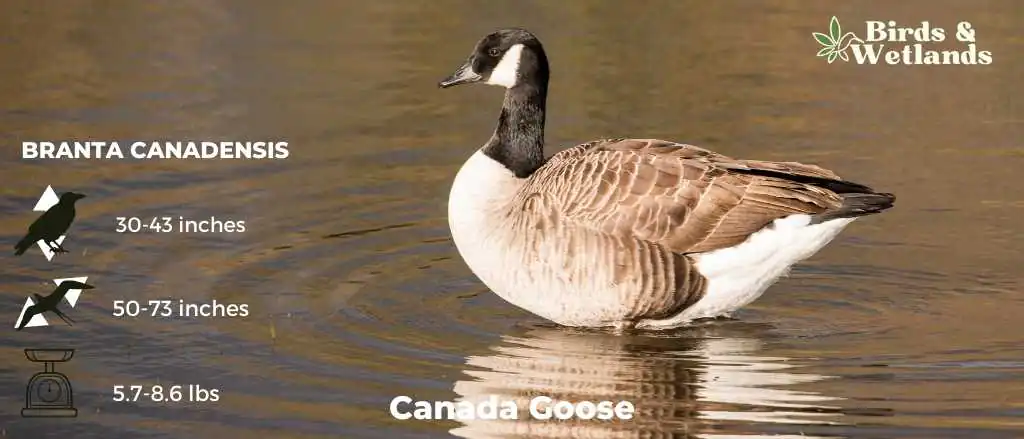

Canada Goose Sound
Scientific Name: Branta canadensis
Length: 30 to 43 in
Wingspan: 50–73 in
Weight: 5.7–14.3 lb
The Canada Goose is a large, well-known species of waterfowl noted for its distinctive appearance, familiar “honk,” and migratory behavior.
Appearance: Both male and female Canada Geese have a similar appearance, featuring a black head and neck with distinctive white patches on the cheeks and chin. The body is primarily brown with a lighter, often white, underbelly.
Diet: Canada Geese primarily feed on plant matter, including grasses, aquatic vegetation, and grains. They can often be seen grazing in parks, lawns, and fields, as well as dabbling in water bodies.
Reproduction: Canada Geese typically nest on the ground near water bodies, often on islands or other isolated areas to avoid predators. The female lays a clutch of about 4 to 6 eggs, which she incubates alone for around a month.
Snow Goose
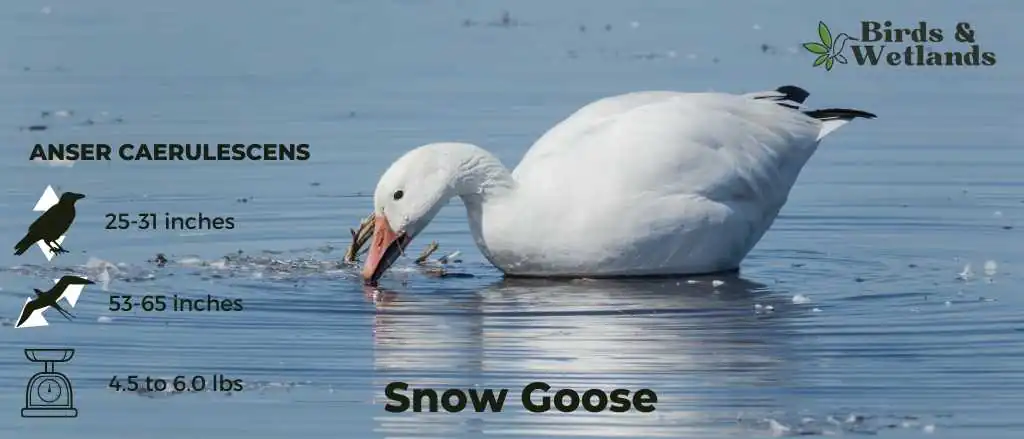
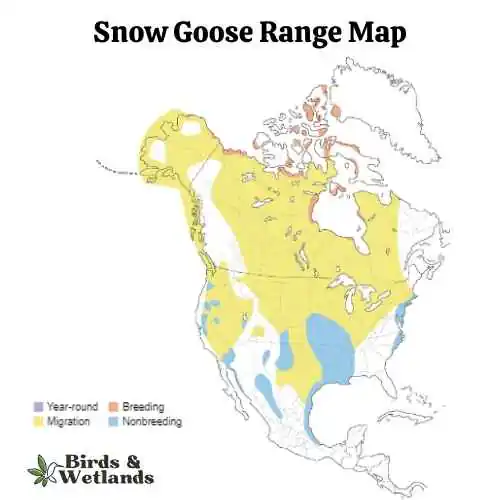
Snow Goose Sound
Scientific Name: Anser caerulescens
Length: 25 to 31 in
Wingspan: 53 to 65 in
Weight: 4.5 to 6.0
The Snow Goose is a large species of waterfowl known for its vibrant white plumage and significant migratory flights.
Appearance: True to their name, Snow Geese are predominantly white with black wingtips. They also have a pink bill, pink legs and feet. A color morph, known as the “Blue Goose,” displays a bluish-gray body with a white head, but is considered the same species.
Diet: Snow Geese primarily feed on plant matter, such as grasses, sedges, and small grains. They can often be seen in large flocks foraging in fields and marshes, and during migration and winter, they can cause considerable damage to agricultural fields due to their feeding habits.
Reproduction: Snow Geese typically nest on the tundra, near water bodies. The female builds the nest and lays a clutch of about 3 to 5 eggs, which she incubates alone for approximately three weeks. Once hatched, the goslings can feed themselves but stay with their parents for protection until they can fly.
Egyptian Goose
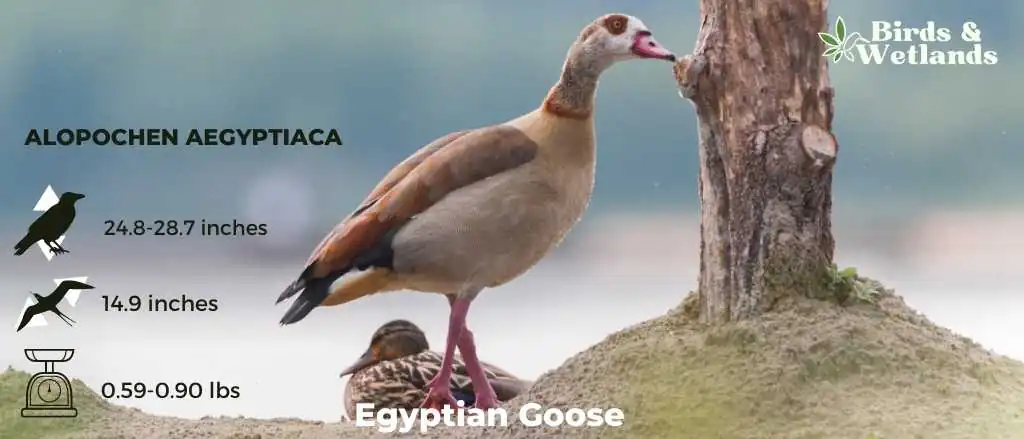
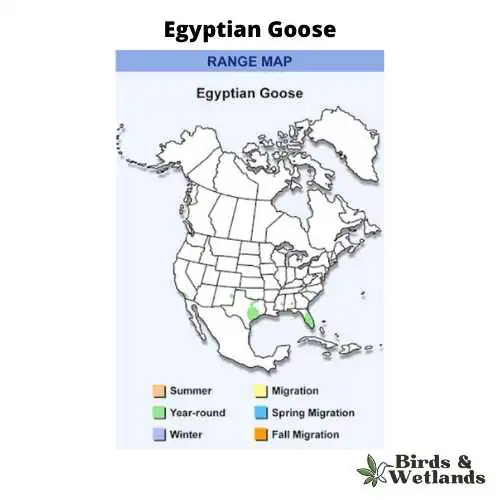
Listen
Scientific Name: Alopochen aegyptiaca
Length: 24.8 to 28.7 cm
Wingspan: 38 cm
Weight:1.5 to 2.3 kgs
The Egyptian Goose is a distinct waterfowl species celebrated for its unique coloration and adaptability to various environments.
Appearance: Egyptian Geese are quite striking, displaying a combination of brown, white, and grey feathers. They also have a chestnut patch around their eyes and on the chest, along with a distinctive dark brown ring around their lower neck. Their pink legs and feet and pinkish bill stand out against their body color.
Diet: The diet of the Egyptian Goose primarily consists of plant matter. They feed on grasses, seeds, leaves, and crops, and can often be seen grazing in fields and on the water’s edge.
Reproduction: Egyptian Geese typically make their nests in a variety of places including tree cavities, reed beds, and cliffs. The female lays a clutch of 5 to 12 eggs, which she incubates for about a month.
Originally native to Africa, the Egyptian Goose has established populations in parts of the United States, where it was introduced through the pet trade. Despite not being native, they have adapted well to American habitats, particularly in suburban and urban areas where they can often be seen in parks and on golf courses.
Where Can you Find Geese in Texas
The Gulf Coast Bird Observatory and the Piney Woods Wildlife Society offer great resources for birding in the state.
Are There Resident Geese Flocks in Texas
Yes, though most Geese come to Texas for the wintering grounds, there are some resident Egyptian Geese and Canada Geese found all year round.
The earliest southbound wintering snow geese arrive in Texas in late September, but most in October. In March, geese that wintered in North Texas leave. The surviving geese breed from April until early August.
Geese are no longer going down to the Texas Coast to overwinter in the large numbers that they used to, partly due to changing farming methods but also because Geese stay in states further north like Oklahoma and Kansas.
Can You Hunt Geese in Texas
Yes, as long as you follow the permits, have a valid licence and hunt during the hunting season. For hunting season, Texas is divided into East and West Texas, each with its own seasons. Duck hunting has overtaken goose hunting in terms of popularity in Texas.
Geese are generally divided into light geese and dark geese. Light geese are snow geese, blue geese (blue geese is just a colour variation on snow geese), and Ross’s geese. Snow geese are also classified as greater snow geese and lesser snow geese, but these are not separate species.
The Canada goose, the white-fronted goose, often known as the speckle belly goose, and the Brant are all examples of dark geese. Neighboring states like Arkansas have similar goose hunting limits, as does Louisiana have goose limits.
When is goose season texas?
Goose hunting season in Texas typically varies each year and is subject to change based on migratory patterns and conservation needs. Generally, it falls between the months of November and February. However, the exact dates can differ depending on the type of goose (Light Geese, Canada Geese, or White-fronted Geese) and the specific zone within Texas. Always be sure to check the current year’s Texas Parks & Wildlife Department hunting regulations for the most accurate and up-to-date information.

